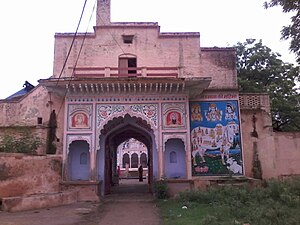Gaushalas or Goshalas (Hindi: गौशाला, romanized: gauśālā) are protective shelters for stray cow in India. Government grants and donations are the primary source of income of the cow shelters in India. Since 2014, when BJP government came into power in India, India has spent ₹5.8 billion (US$69 million) on cow shelters in two years between 2014 and 2016.[1]


Description
editGoshala, a Sanskrit word ("Go" means cow and "Shala" means a shelter place: Go + Shala = shelter for cows), means the abode or sanctuary for cows, calves and oxen.[2]
History
editThe first Gaurakshini sabha (cow protection society) was established in Punjab in 1882.[3] The movement spread rapidly all over North India and to Bengal, Bombay, Madras presidencies and other central provinces. The organization rescued wandering cows and reclaimed them to groom them in places called gaushalas. Charitable networks developed all through North India to collect rice from individuals, pool the contributions, and re-sell them to fund the gaushalas. Signatures, up to 350,000 in some places, were collected to demand a ban on cow sacrifice.[4] Between 1880 and 1893, hundreds of gaushalas were opened.[5] Pathmeda godham is the largest Gaushala in India with over 85000 cows being sheltered in the small town of Pathmeda in southern Rajasthan.[6]
Government grants
editSince the BJP government came into power in India in 2014, India has spent ₹5.8 billion (US$69 million) on cow shelters in between the years 2014 and 2016.[1]
To prevent unproductive cows being sent to the abattoir, the government started the Rashtriya Gokul Mission in mid-2014, a national program that involves constructing havens for retired cows. Proceeds from the animals' bodily waste are intended to pay for their upkeep. In May 2016, the Indian national government held an inaugural national conference on goshalas. The Niti Ayog is working on developing a roadmap for Gaushala economy to develop commercial use of cow urine and cow dung for various purposes.[7]
Other sources of income
editDonations are the only source of income for the Goshala. Some goshalas offer yoga and music lessons for additional income.[8][better source needed]
See also
editReferences
edit- ^ a b "Cow urine can sell for more than milk in India". Bloomberg.com. 2016-07-18. Retrieved 2016-09-18.
- ^ "300 cattle head for goshala everyday". The Times of India. 2011-08-17. Archived from the original on 2013-11-10. Retrieved 2013-02-06.
- ^ The Making of an Indian Metropolis, Colonial governance and public culture in Bombay, 1890/1920, Prashant Kidambi, p. 176, ISBN 978-0-7546-5612-8.
- ^ Vishnu's crowded temple, India since the great rebellion, pp. 67-69, Maria Misra, 2008, Yale University Press, ISBN 978-0-300-13721-7.
- ^ "Report of the National Commission on Cattle - Chapter I (10. Beginning of mass protests against cow-killings)". Dahd.nic.in. Archived from the original on 27 September 2013. Retrieved 10 November 2013. This article incorporates text from this source, which is in the public domain.
- ^ Gupta, Abhinav (2016-04-13). "Shri Pathmeda Godham Mahatirth: World's largest cowshed". www.indiatvnews.com. Retrieved 2022-02-08.
- ^ Sharma, Yogima Seth. "Niti Aayog working on road map to develop Gaushala economy". The Economic Times. Retrieved 2022-02-08.
- ^ "Shri Shaktidarshan Yogashram". Retrieved 2021-03-01.
External links
edit- Media related to Goshalas at Wikimedia Commons